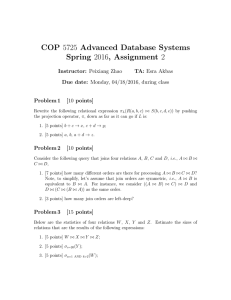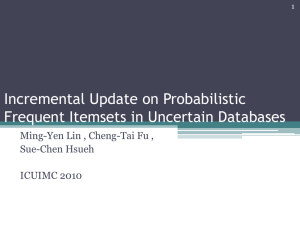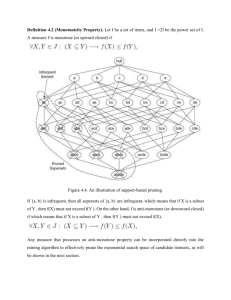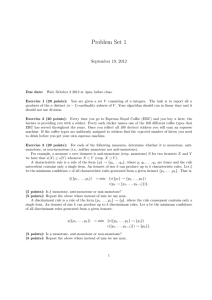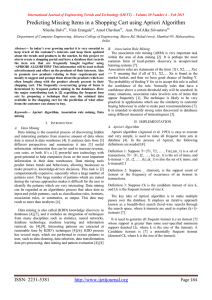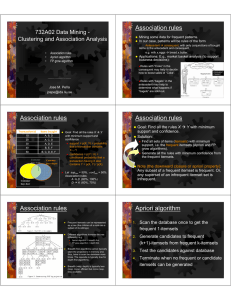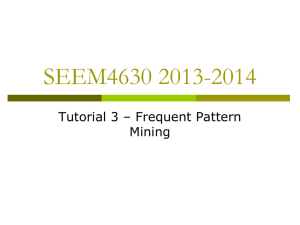CIS 4930 Data Mining Spring 2016, Assignment 2
advertisement
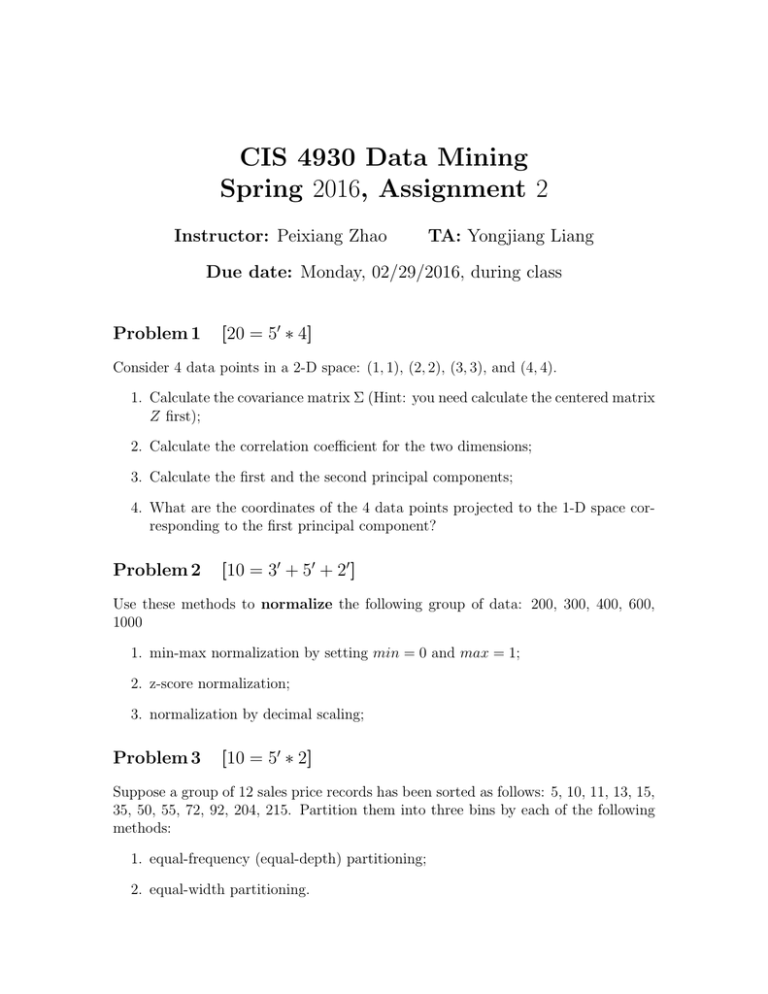
CIS 4930 Data Mining
Spring 2016, Assignment 2
Instructor: Peixiang Zhao
TA: Yongjiang Liang
Due date: Monday, 02/29/2016, during class
Problem 1
[20 = 50 ∗ 4]
Consider 4 data points in a 2-D space: (1, 1), (2, 2), (3, 3), and (4, 4).
1. Calculate the covariance matrix Σ (Hint: you need calculate the centered matrix
Z first);
2. Calculate the correlation coefficient for the two dimensions;
3. Calculate the first and the second principal components;
4. What are the coordinates of the 4 data points projected to the 1-D space corresponding to the first principal component?
Problem 2
[10 = 30 + 50 + 20 ]
Use these methods to normalize the following group of data: 200, 300, 400, 600,
1000
1. min-max normalization by setting min = 0 and max = 1;
2. z-score normalization;
3. normalization by decimal scaling;
Problem 3
[10 = 50 ∗ 2]
Suppose a group of 12 sales price records has been sorted as follows: 5, 10, 11, 13, 15,
35, 50, 55, 72, 92, 204, 215. Partition them into three bins by each of the following
methods:
1. equal-frequency (equal-depth) partitioning;
2. equal-width partitioning.
2
CIS 4930: Data Mining
Problem 4
[15 = 7.50 ∗ 2]
The Apriori algorithm makes use of the prior knowledge of subset support properties.
1. Given a frequent itemset l and a subset s of l, prove that the confidence of the
rule s0 → (l − s0 ) cannot be more than the confidence of s → (l − s), where s0
is a subset of s;
2. A partitioning variation of Apriori subdivides the transactions of a database D
into n nonoverlapping partitions. Prove that any itemset that is frequent in D
must be frequent in at least one partition of D.
Problem 5
[30 = 120 + 20 + 20 + 20 + 120 ]
The Apriori algorithm uses a candidate generation and frequency counting strategy
for frequent itemset mining. Candidate itemsets of size (k + 1) are created by joining
a pair of frequent itemsets of size k. A candidate is discarded if any one of its
subsets is found to be infrequent during the candidate pruning step. Suppose the
Apriori algorithm is applied to the transaction databases, as shown in Table 1 with
minsup = 30%, i.e., any itemset occurring in less than 3 transactions is considered
to be infrequent.
Table 1: A Sample of Marekt Basket Transactions
Transaction ID
1
2
3
4
5
6
7
8
9
10
Items Bought
{a, b, d, e}
{b, c, d}
{a, b, d, e}
{a, c, d, e}
{b, c, d, e}
{b, d, e}
{c, d}
{a, b, c}
{a, d, e}
{b, d}
1. Draw an itemset lattice representing the transaction database in Table 1. Label
each node in the lattice with the following letters:
• N: If the itemset is not considered to be a candidate itemset by the Apriori
algorithm.
• F: If the itemset is frequent;
• I: If the candidate itemset is infrequent after support counting.
Spring 2016
Assignment 2
CIS 4930: Data Mining
3
Figure 1: FP-tree of a Transaction Database.
2. What is the percentage of frequent itemsets (w.r.t. all itemsets in the attice)?
3. What is the pruning ratio of the Apriori algorithm on this database (Pruning
ratio is defined as the percentage of itemsets not considered to be a candidate)?
4. What is the false alarm rate (False alarm rate is the percentage of candidate
itemsets that are found to be infrequent after performing support counting)?
5. Redraw the itemset lattice representing the transaction database in Table 1.
Label each node with the following letter(s):
• M: if the node is a maximal frequent itemset;
• C: if it is a closed frequent itemset;
• N: if it is frequent but neither maximal nor closed;
• I: if it is infrequent.
Problem 6
[15 = 50 ∗ 3]
A database with 150 transactions has its FP-tree shown in Figure 1. Let the relative
minsup = 0.4 and minconf = 0.7.
1. Show c’s projected database;
2. Present all frequent 3-itemsets and 2-itemsets;
3. Show all the association rules with the format of XY → Z with the support
and confidence values. Here X, Y , and Z are items in the transaction database.
Spring 2016
Assignment 2
